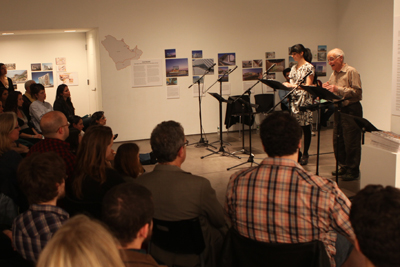by admin

Actors Michele Rafic and Yusef Bulos in The House
Laura Trimble
Event: Building ANew: Noor Theatre Presents a Reading of Short Plays by Award-winning Middle Eastern Playwrights.
Location: Center for Architecture, 03.16.2012
Playwrights: Jacob Kader, Ismail Khalidi, Mona Mansour, Tala Manassah, Daria Polatin, Najla Said, Sam Neave, and Heather Raffo.
Director: Pirronne Yousefzadeh
Cast: Leila Buck, Yusef Bulos, Piter Marek, Eric Miller, Michele Rafic, Darrill Rosen, Najla Said, and Daniel Shamoun.
Organizer: Noor Theatre
Benefactor: A. Estéban & Company
Lead Sponsor: Buro Happold
Sponsors: Eytan Kaufman Design and Development; FXFOWLE
Supporters: Arup; Columbia University, Graduate School of Architecture, Planning and Preservation; Dewan Architects & Engineers; GAD; HDR; Kohn Pedersen Fox Associates; NAGA Architects; Ramla Benaissa Architects; RBSD Architects; Skidmore, Owings & Merrill; World Monuments Fund; Zardman
“I’m not sure what this is—a theater?” So begins “The House” by Mona Mansour and Tala Manassah, one of several plays featured in a recent reading by the Noor Theatre at the Center for Architecture. The opening line of the play was a fitting question, posed as it was at a venue not commonly known for its theatrical productions. But, as AIANY Executive Director Rick Bell, FAIA, noted, the Center was once home to Fringe Festival events, and the evening proved to be a similarly lively intersection between theater and architecture. Bell’s informal poll of the audience found that half came from the theater world and half from architecture.
The evening of readings added another dimension to the Center’s current exhibitions, “CHANGE: Architecture and Engineering in the Middle East, 2000-Present” and “City of Mirages: Baghdad, 1952-1982.” The piece “Build, Forget” by Ismail Khalidi staged the design of a fictional competition project that could have been inspired by many of the works on the walls.
Each play from Noor, which supports and presents the work of playwrights of Middle Eastern decent, was commissioned by the Center for Architecture specifically for the event. The playwrights’ intentions to create dialogue about space and cities were evident, and their approaches to the subject varied widely. The plays conjured deeply personal experiences of daily life in the Middle East, leading the audience on a walk through a few cities, across a few decades, and into a few homes and apartments.
A projected backdrop of scenery during the first moments of each piece was the only visual cue employed, but each play had its own way of evoking a space. “A Room for Each Season,” by Heather Raffo, juxtaposed contemporary Baghdad with the city’s heyday, at one moment describing gossip communicated through kissing mashrabiyas and at the next noting that the new U.S. Embassy covers 94 football fields. “Perimeters for safety have exploded in every space, every psyche. How do you design safety outside a wall?” asked the monologue.
The play “The Magic Carpet Hides the Hole in the Ceiling,” by Najla Said, manifests a similar anxiety arising from the history of conflict in the region. The speaker tells us that since she was a girl she has known when the ceiling falls it is as a sign of war and catastrophe. Like many of the other short plays, “The Magic Carpet” uses a description of space as a trigger to talk about current events, or as an elegy for loss by migration or destruction, offering a reminder to architects of the pivotal that role space plays in imagination and memory.
Greta Hansen is a New York-based architectural designer and writer.

